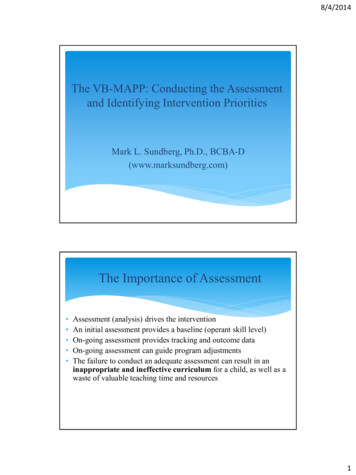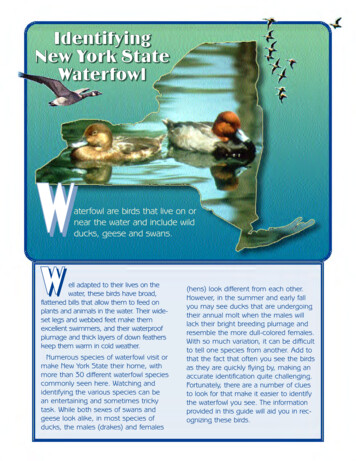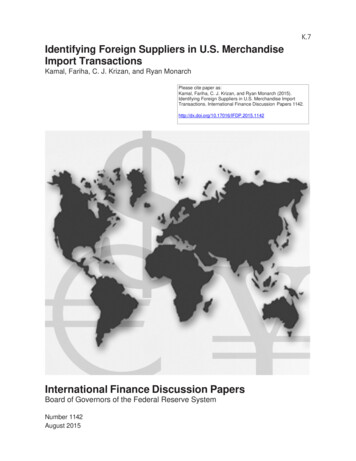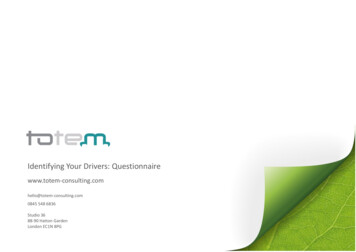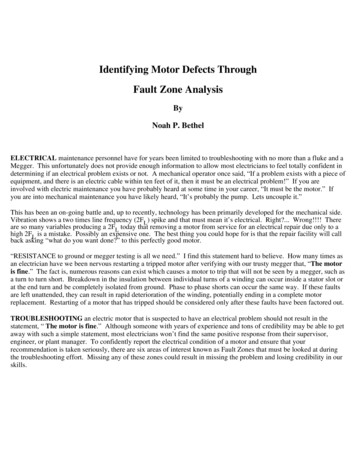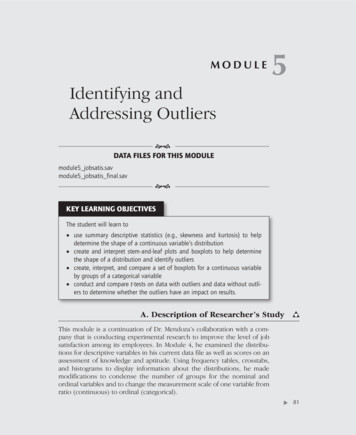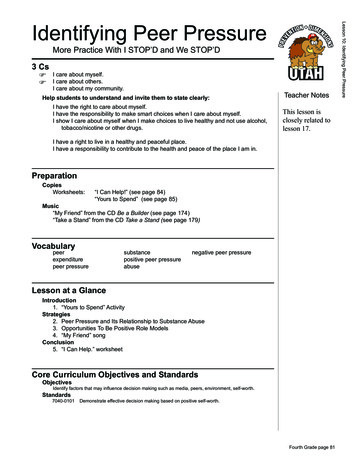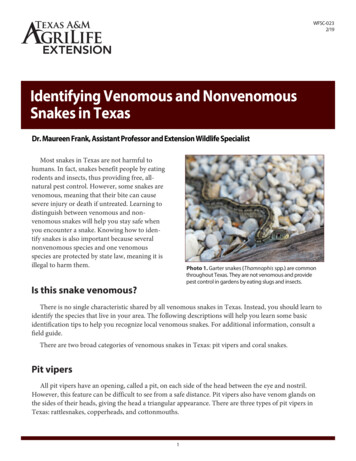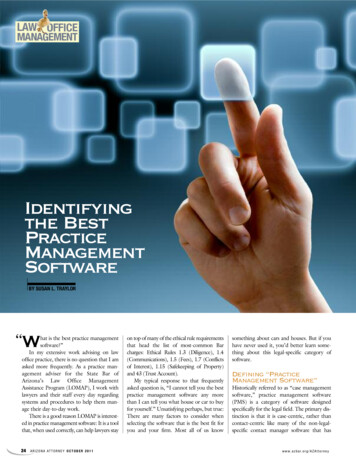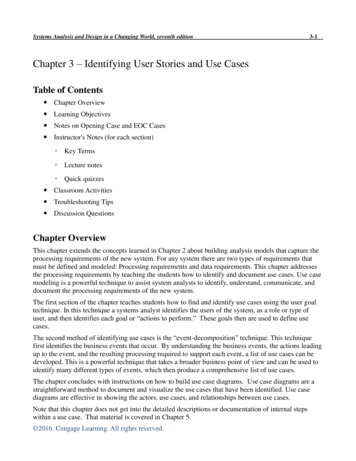
Transcription
Systems Analysis and Design in a Changing World, seventh edition3-1Chapter 3 – Identifying User Stories and Use CasesTable of Contents Chapter Overview Learning Objectives Notes on Opening Case and EOC Cases Instructor's Notes (for each section) Key Terms Lecture notes Quick quizzes Classroom Activities Troubleshooting Tips Discussion QuestionsChapter OverviewThis chapter extends the concepts learned in Chapter 2 about building analysis models that capture theprocessing requirements of the new system. For any system there are two types of requirements thatmust be defined and modeled: Processing requirements and data requirements. This chapter addressesthe processing requirements by teaching the students how to identify and document use cases. Use casemodeling is a powerful technique to assist system analysts to identify, understand, communicate, anddocument the processing requirements of the new system.The first section of the chapter teaches students how to find and identify use cases using the user goaltechnique. In this technique a systems analyst identifies the users of the system, as a role or type ofuser, and then identifies each goal or “actions to perform.” These goals then are used to define usecases.The second method of identifying use cases is the “event-decomposition” technique. This techniquefirst identifies the business events that occur. By understanding the business events, the actions leadingup to the event, and the resulting processing required to support each event, a list of use cases can bedeveloped. This is a powerful technique that takes a broader business point of view and can be used toidentify many different types of events, which then produce a comprehensive list of use cases.The chapter concludes with instructions on how to build use case diagrams. Use case diagrams are astraightforward method to document and visualize the use cases that have been identified. Use casediagrams are effective in showing the actors, use cases, and relationships between use cases.Note that this chapter does not get into the detailed descriptions or documentation of internal stepswithin a use case. That material is covered in Chapter 5. 2016. Cengage Learning. All rights reserved.
Systems Analysis and Design in a Changing World, seventh edition3-2Learning ObjectivesAfter reading this chapter, the student should be able to: Explain why identifying user storied and use cases is the key to defining functionalrequirements Write user stories with acceptance criteria Describe the two techniques for identifying use cases Apply the user goal technique to identify use cases Apply the event decomposition technique to identify use cases Describe the notation and purpose for the use case diagram Draw use case diagrams by actor and by subsystemNotes on Opening Case and EOC CasesOpening CaseWaiters on Call Meal-Delivery System: This case shows how the analyst uses events—and the usecases they trigger—to summarize what the users require in their order and delivery system. As the usersdiscuss their business, the analyst notes what events occur that require the system to respond in someway. A suggested in-class exercise is to complete a list of use cases.Key points to note include: Events (and use cases) can be discovered by talking with the users. Talking about events is natural for business-oriented users. The analyst can focus on requirements independent of current or proposed technology (a logicalmodel), which is something that students often find difficult. Even if the users want to talkabout technology, it is important to define the requirements in this way.EOC CasesThe running cases go throughout the rest of the book, e.g. for each chapter.The State Patrol Ticket-Processing System: This case describes a traffic ticket system that mustinterface with other systems. One benefit of this case is that the students must identify use cases thatbelong only to the ticket-processing system. In other words, they should not include use cases for theother systems that receive information from, or sent information to the ticket-processing system. This isa good exercise to teach students to identify only appropriate use cases.Community Board of Realtors (running case): Community Board of Realtors is a professional 2016. Cengage Learning. All rights reserved.
Systems Analysis and Design in a Changing World, seventh edition3-3organization that supports real estate offices and agents. This chapter describes many of the processingand informational requirements of real estate agents. Students are asked to identify use cases and builda use case diagram based needs of real estate agents. Students are also asked to act as a real estatebuyer and identify any other use cases, e.g. information and processes for customers that they desire.Spring Breaks 'R' Us Travel Services (SBRU) (running case): SBRU is an online travel services thatbooks spring break trips to resorts for college students. This chapter describes student activities to findand book reservations for spring break vacation trips. Students are asked to identify appropriate usecases and draw a use case diagram. The second problem in this case asks students to consider their owndesires, as student customers, on what social networking functions they might also want to include inthis system. This should provide some interesting answers.On the Spot Courier Services (running case): On the Spot is a small, but growing, courier service thatneeds to track customers, package pickups, package deliveries, and delivery routes. This chapterdescribes many of the functions that the new system must provide. Since there are multiple actors thatwill use the system, the students are asked to first identify the actors and then the associated use cases.Finally the students are asked to find use cases specifically using the event decomposition technique.Sandia Medical Devices (running case): Sandia Medical Devices is a company that specializes inmedical monitoring through remote, mobile telecommunication devices. This chapter provides a richdescription of processing and requirements of both patients and medical professionals. The students areasked to identify the actors and the associated use cases. They are asked to use the eventdecomposition technique to find use cases.Instructor's NotesUser Stories and Use CasesKey Terms user story – one short sentence in everyday language of the end user that states what a userdoes as part of his or her work acceptance criteria – features that must be present in the final system for the user to besatisfied use case – an activity that the system performs, usually in response to a request by a userLecture NotesUser stories and use cases are very closely related concepts. User stories are simple, one sentencedescriptions of a user task that utilizes the system. User stories are normally created by the usersthemselves. User stories are used in highly Agile development projects where there is ongoing userinvolvement. The template for a user story is in this form:As a role played , I want to goal or desire so that reason or benefit Use cases also define the tasks that a user does that utilizes the system. However, use cases are usually 2016. Cengage Learning. All rights reserved.
Systems Analysis and Design in a Changing World, seventh edition3-4documented more thoroughly and with more detail. Often a use case will also be modeled using aworkflow diagram or detailed description that identifies the various steps included in the use case. Thedetail definition of a use case normally requires the expertise of a systems analyst.Inasmuch as the description of a user story is rather brief, an acceptance criteria is also described withthe user story. The acceptance criteria identifies the conditions that must be present in the finaloutcome in order for the user to be satisfied.Quick QuizQ: Who takes responsibility to document a user story?A: The users themselvesQ: What are the differences and similarities between a user story and a use case?A: A user story is a brief one sentence statement without detailed documentation, but withacceptance criteria defined. A use case is usually more detailed and can be documented withdetailed steps. Both describe the user’s tasks and processes.Use Cases and the User Goal TechniqueKey Terms user goal technique – a technique to identify use cases by determining what specific goals orobjectives must be completed by a userLecture NotesOne approach to identifying use cases, called the user goal technique, is to ask users to describe theirgoals for using the new or updated system. The analyst first identifies all the users and then conducts astructured interview with each user. A user goal can be thought of as a piece of work, or a task, that theuser must complete. For example, for an RMO a shipping clerk might have a goal such as ship items,or track shipments.The user goal technique for identifying use cases includes these steps:1. Identify all the potential users for the new system.2. Classify the potential users in terms of their functional role (e.g., shipping, marketing, sales).3. Further classify potential users by organizational level (e.g., operational, management,executive).4. For each type of user, interview them to find a list of specific goals they will have when usingthe new system. Start with goals they currently have and then get them to imagine innovativefunctions they think would add value. Encourage them to state each goal in the imperative verbnoun form, such as Add customer, Update order, and Produce month end report. Create a list ofpreliminary use cases organized by type of user. 2016. Cengage Learning. All rights reserved.
Systems Analysis and Design in a Changing World, seventh edition3-55. Create a list of preliminary use cases and organize it by type of user.6. Look for duplicates with similar use case names and resolve inconsistencies.7. Identify where different types of users need the same use cases.8. Review the completed list with each type of user and then with interested stakeholders.Quick QuizQ: What is the primary source of use cases in the user goal technique?A: An interview with the user.Use Cases and Event DecompositionKey Terms event decomposition technique – a technique to identify use cases by determining the externalbusiness events to which the system must respond elementary business processes (EBPs) – the most fundamental tasks in a business process,which leaves the system and data in a quiescent state; usually performed by one person inresponse to a business event event – something that occurs at a specific time and place, can be precisely identified, and mustbe remembered by the system external event – an event that occurs outside the system, usually initiated by an external agent actor – an external agent; a person or group that interacts with the system by supplying orreceiving data temporal event – an event that occurs as a result of reaching a point in time state event – an event that occurs when something happens inside the system that triggers someprocess system controls – checks or safety procedures to protect the integrity of the system and the data perfect technology assumption – the assumption that a system runs under perfect operatingand technological conditionsLecture NotesThe most comprehensive technique for identifying use cases is the event decomposition technique.The event decomposition technique begins by identifying all the business events that will cause theinformation system to respond, and each event leads to a use case. Starting with business events helpsthe analyst define each use case at the right level of detail. The appropriate level of detail foridentifying use cases is one that focuses on elementary business processes (EBPs). An EBP is a taskthat is performed by one person in one place in response to a business event, adds measurable business 2016. Cengage Learning. All rights reserved.
Systems Analysis and Design in a Changing World, seventh edition3-6value, and leaves the system and its data in a stable and consistent state.Event Decomposition TechniqueThe event decomposition technique focuses on identifying the events to which a system must respondand then determining how a system must respond (i.e., the system’s use cases). When defining therequirements for a system, it is useful to begin by asking, “What business events occur that will requirethe system to respond?”Types of EventsExternal Events: An external event is an event that occurs outside the system—usually initiated by anexternal agent or actor. An external agent (or actor) is a person or organizational unit that supplies orreceives data from the system. To identify the key external events, the analyst first tries to identify allthe external agents that might want something from the system. A classic example of an external agentis a customer. When describing external events, it is important to name the event so the external agentis clearly defined. The description should also include the action that the external agent wants topursue.Temporal Events: A temporal event is an event that occurs as a result of reaching a point in time. Forexample, on month-end certain automatic processing may need to be initiated. The analyst beginsidentifying temporal events by asking about the specific deadlines that the system must accommodate.What outputs are produced at that deadline? What other processing might be required at that deadline?State Events: A state event is an event that occurs when something happens inside the system thattriggers the need for processing. For example a state event can occur when an inventory level reaches apre-order point.Identifying EventsEvents versus Prior Conditions and Responses: It is sometimes difficult to distinguish between anevent and part of a sequence of prior conditions that leads up to the event. The way to determinewhether an occurrence is an event
The State Patrol Ticket-Processing System: This case describes a traffic ticket system that must interface with other systems. One benefit of this case is that the students must identify use cases that belong only to the ticket-processing system. In other words, they should not include use cases for the


